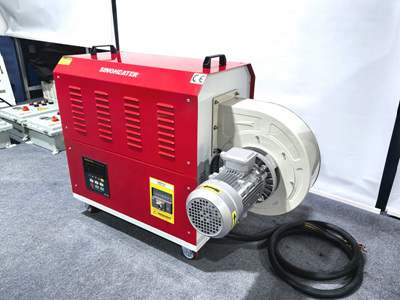The fan blade is one of the core components of the hot air blower, and its performance directly affects the air volume, air pressure and the service life of the equipment. If not maintained properly, it may lead to decreased efficiency, increased noise and even equipment failure. The following are the key points for the daily maintenance of fan blades, covering cleaning, inspection, lubrication and safe operation:
First, cleaning and dust removal
Clean the accumulated dust regularly
Frequency: Clean once every 1 to 3 months depending on the usage environment (such as dust concentration). For highly polluted environments, the cycle should be shortened.
Method:
Shut down and cut off power: Ensure that the equipment has completely stopped and the power supply is cut off.
Soft brush or vacuum cleaner: Use a soft-bristled brush to gently sweep the dust off the surface of the blades, or use an industrial vacuum cleaner (with a flat-nosed suction head) to remove accumulated dust.
Avoid water washing: Do not directly rinse the blades with water to prevent water from entering the motor or rusting of metal parts.
Treatment of stubborn stains
Specialized cleaner: If the leaves are stained with oil or gum, they can be wiped with a neutral cleaner (such as alcohol) dipped in a soft cloth to prevent corrosion of the leaf coating.
Drying treatment: After cleaning, wipe dry with a dry cloth or let it air dry naturally to ensure no moisture remains.
Second, structural inspection and tightening
Blade integrity inspection
Visual inspection: Observe whether the blades have cracks, deformations or notches, with particular attention paid to the tip and leading edge of the blades.
Dynamic balance test: If the blades show obvious deformation or uneven weight distribution, dynamic balance correction is required (professional equipment is needed).
Fastener inspection
Bolts and nuts: Check if the connecting bolts between the blades and the hub are loose. Use a torque wrench to re-tighten them according to the manufacturer’s specified values (such as 8-12N·m).
Anti-loosening measures: For high-frequency vibration equipment, anti-loosening gaskets or thread adhesives can be installed.
Third, lubrication and rust prevention
Bearing lubrication
Lubrication cycle: Replenish the grease (such as lithium-based grease) every 6 months or after 1000 hours of operation.
Lubrication amount: Add 1/3 to 1/2 of the bearing capacity to avoid excessive lubrication causing leakage.
Anti-rust treatment
Metal blades: If the blades are made of metal, anti-rust paint or anti-rust oil (such as WD-40) can be sprayed, especially for the welded parts.
Storage environment: When not in use for a long time, store the hot air blower in a dry and well-ventilated place to avoid rust caused by moisture.
Fourth, operation monitoring and adjustment
Noise and vibration monitoring
Abnormal judgment: If abnormal noise or vibration occurs during operation, stop the machine immediately to check whether the blades are loose, deformed or have accumulated excessive dust.
Vibration analysis: Use a vibration detector (such as a handheld vibration meter) to monitor the vibration value. If it exceeds the standard (such as ISO 10816-3), the cause needs to be investigated.
Calibration of air volume and air pressure
Regular testing: Measure the air velocity at the air outlet with an anemometer every six months. If the air volume drops by more than 10%, check whether the blades are worn or dusty.
Angle adjustment: For hot air fans with adjustable blade angles, adjust to the optimal Angle (such as 30°-45°) according to the manufacturer’s manual.
Fifth, safety and protection
Operational safety
Power-off maintenance: Before all maintenance operations, the power supply must be cut off and a warning sign reading “Do Not Close the Switch” must be hung.
Protective equipment: Wear goggles, gloves and dust masks during maintenance to prevent dust or debris from splashing.
Inspection of protective devices
Protective net and casing: Ensure that the fan’s protective net is undamaged and the casing is well sealed to prevent foreign objects from entering and damaging the blades.
Sixth, maintain records and plans
Establish and maintain archives
Record the time, content, replaced parts and inspection data of each maintenance to facilitate the tracking of equipment status.
Formulate a maintenance plan
Based on the frequency of equipment usage and environmental conditions, formulate annual/quarterly/monthly maintenance plans to ensure their regular implementation.
Summary
The daily maintenance of wind turbine blades should follow the closed-loop process of “cleaning – inspection – lubrication – monitoring”, with a focus on dust removal, structural integrity and dynamic balance status. Regular maintenance can extend the blade life by 2 to 3 times, reduce energy consumption by 10% to 15%, and decrease the risk of sudden failures. In case of complex problems (such as blade breakage), the machine should be stopped immediately and professional personnel should be contacted for handling.




